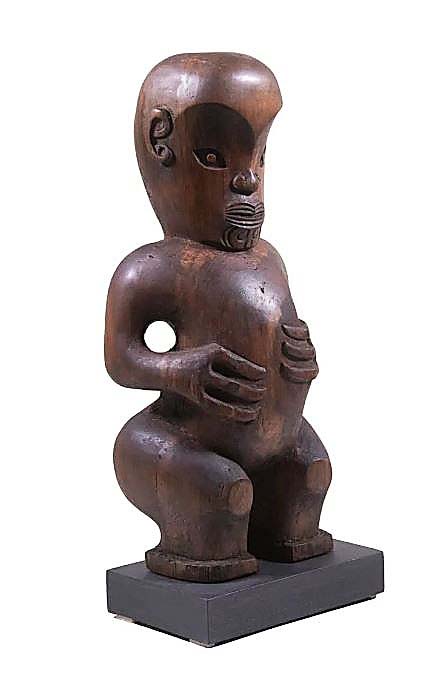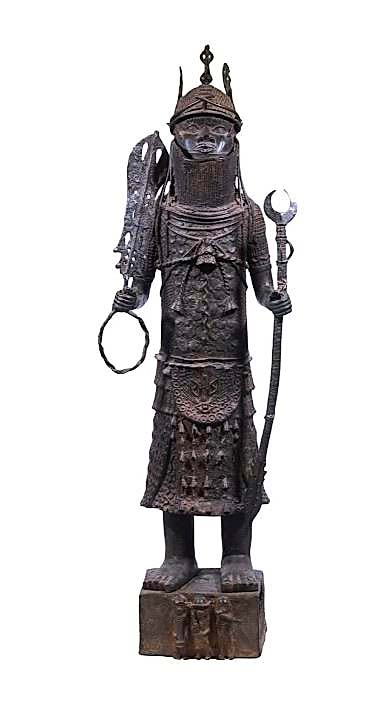
Māori New Zealand Oceanic Gable “Tekoteko” totem ancestor spirit figure, 15 1/4″ tall, was the top lot, selling for $10,625 against a $400-600 estimate.
Review by W.A. Demers; Photos Courtesy Thomaston Place Auction Galleries
THOMASTON, MAINE — Thomaston Place Auction Galleries presented collections of international tribal artifacts and antiquities in a two-day sale on September 22-23. Crossing the block were groups of Native American/Inuit, African, Oceanic, Pre-Columbian and ancient Mediterranean artifacts gathered from estates and collections throughout the Northeastern United States.
Thomaston Place Auction Galleries owner and auctioneer Kaja Veilleux said, “We gathered an exciting inventory of rare items, representing the creative energy of diverse cultures from ancient to modern times.”
In all, more than 400 African items were offered to bidders live and in-person, as well as by phone, absentee and online. Leading the results was a Maori New Zealand Oceanic Gable “Tekoteko” totem ancestor spirit figure, 15¼ inches tall, that rose well above its $400/600 estimate to realize $10,625.
Day 1 began with 100 lots of antiquities from the estate of US Foreign Service diplomat John Clayton and JoAnn Clayton-Townsend that were collected throughout the Mediterranean region. The couple gathered examples of ancient glass, alabaster and marble sculptures, terracotta figures and vessels, bronze objects and a variety of early lamps.

Important carved sperm whale tooth, depicting a large totem pole with swastika on one side, another smaller version on the opposite side, earned $3,750.
The next highest price was captured by a New Caledonia Island Eighteenth-Nineteenth Century wood carving that sold for $9,375. This would have been used as an important spire figure to adorn a chieftain’s house. At 41 inches tall, it had cataloged provenance to Ernest Le Veel, 1874-1971, Paris; Odette, 1925-2012, and Rene, 1901-1998, Delenne Bruxelles.
Fetching $6,875 was a Polynesian whale tooth necklace from Eighteenth Century Fiji Island. It was deemed to be an early pre-contact chieftain status necklace with original sennit fiber and 2½-inch teeth on a 20-inch necklace. It was wired to display on a 13-by-13-inch stand and had provenance to English Dr Frank Burnett.
From the estate of Col. Leroy Barton (1887-1959) of Port Washington, N.Y., former harbormaster for New York City during World War II, came a Nineteenth Century Iroquois false face mask. The carved wood had black and white pigment, attached horse hair, inset tin eyes and stood 14 inches high. It brought $6,000.

Nineteenth Century Iroquois grotesque face mask, carved wood with black and white pigment, attached horsehair, inset tin eyes., 14 inches tall, was bid to $6,000.
Depicting a flying zoomorphic deity stretched out on the sun wheel with traces of original polychrome pigments, a Maya culture (Mexico) flute (550-950 CE) went out at $5,312. It was 9 inches high, 4 inches wide and had once been in the collection of Art Institute of Chicago.
North American Indian peoples were known to utilize buffalo or deerskin hides with the hair removed to a two-sided bag called a parfleche to carry clothing or food, beginning in the late reservation period. An example from this period, circa 1880s, probably Tetons, featured rawhide with brightly colored painted geometric decoration. It had an oval bottom, black wool deerskin stitched edging and a laced closure flap. Included with the bag, which sold for $4,688, was a 2017 receipt from Fighting Bear Antiques of Jackson, Wyo., for $1,750.
Day 2’s highlights were led by a life-sized Benin bronze warrior king at $4,375. The cast bronze standing figure on integral plinth depicted a man in full battle regalia, holding a scepter and sword, basketry helmet with crests, mesh gown having bells and bangles, the platform featuring three lesser warriors on front.

A life-sized Benin Bronze warrior king standing on an integral plinth was in full battle regalia, holding a scepter and sword, making $4,375.
A Valdivian stone plaque, Ecuador, 3500-2000 BCE, was of gray limestone, carved in low relief. Such items were used for divination, or possibly a star chart; such plaques are the earliest evidence of “writing” in the Americas. On a museum stand, 8½ by 11½ inches, had provenance to Daniel W. Boesendahl, New York City, and left the gallery at $3,750.
Prices given include the buyer’s premium as stated by the auction house. For information, www.thomastonauction.com or 207-354-8141.












